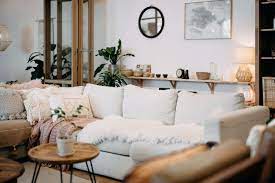In a world that thrives on innovation and rapid change, the concept of home remains a timeless sanctuary. Our homes are more than just physical structures; they are the embodiment of our personalities, lifestyles, and aspirations. This is where the art of functional interior decorating comes into play, ensuring that our living spaces not only reflect our individuality but also serve us seamlessly in our daily lives.
At Practical Solutions, we understand that interior decorating goes beyond aesthetics – it’s about creating spaces that enhance functionality, promote productivity, and evoke a sense of tranquility. In this blog post, we will delve into the essence of functional interior decorating, exploring how it can transform your living spaces into havens of harmony and efficiency.
- The Marriage of Aesthetics and Functionality
When it comes to interior decorating, striking the right balance between aesthetics and functionality is key. It’s not about choosing between a visually appealing space and a practical one; it’s about achieving both. This balance begins with a deep understanding of your needs and preferences. Before embarking on any design journey, take some time to evaluate your daily routines, habits, and the activities that take place in each room. This insight will guide your design choices, ensuring that every piece of furniture, every color, and every arrangement serves a purpose. - Decluttering for Serenity
A cluttered space can hinder your productivity and create unnecessary stress. Functional interior decorating often starts with decluttering – a process that involves eliminating items that no longer serve a purpose. Begin by sorting your belongings into categories: keep, donate, and discard. This process not only clears physical clutter but also opens up mental space for creativity and clarity. - Furniture as Multifunctional Pieces
In modern living, where space is often at a premium, investing in multifunctional furniture can be a game-changer. Furniture pieces that can serve multiple purposes – like a sofa that converts into a bed or a coffee table with built-in storage – can help optimize your space without compromising on style. - Strategic Layouts
The arrangement of furniture and decor can significantly impact the flow and functionality of a room. Consider the “golden triangle” rule in the kitchen, where the refrigerator, stove, and sink form a triangular layout for optimal efficiency. In living rooms, create conversation areas by arranging seating in a way that encourages interaction while allowing easy access to other parts of the room. - Lighting for Ambiance and Task Efficiency
Lighting is an often underestimated element of interior decorating. It can affect mood, ambiance, and even your ability to perform tasks efficiently. Natural light is a treasure, so make sure to maximize it through well-placed windows and mirrors. Additionally, layer your lighting sources with ambient, task, and accent lighting to create depth and functionality in every room. - Personalization and Reflection of Identity
While functionality is paramount, your home should also reflect your unique personality and style. Incorporate elements that resonate with you, whether it’s through art, textiles, or decorative items. A well-chosen piece of art can serve as a conversation starter and add character to your space. - Embracing Technology
In the digital age, technology has become an integral part of our lives. Integrating smart home systems can elevate the functionality of your interiors. From programmable thermostats that adjust to your preferences to voice-controlled lighting, technology can make daily tasks more convenient and efficient. - The Zen of Minimalism
Minimalism is not just a design trend; it’s a philosophy that emphasizes the importance of simplicity and mindful consumption. Embracing a minimalist approach in interior decorating can lead to cleaner lines, less visual clutter, and a sense of tranquility. Keep only what adds value to your space and let go of excess. - Designing for Tranquility
A functional interior is not only about efficiency; it’s also about creating an environment that nurtures relaxation and well-being. Consider incorporating calming colors, natural textures, and elements from nature to evoke a sense of tranquility. Indoor plants, for example, not only add visual appeal but also contribute to improved air quality. - Continuous Evolution
Lastly, remember that your home is a reflection of your journey. As your needs and preferences evolve, so should your interiors. Regularly reassess your living spaces and make adjustments to accommodate new changes in your life.
In conclusion, functional interior decorating is an art that marries aesthetics with practicality, creating living spaces that are both visually appealing and seamlessly functional. At Practical Solutions, we believe that a well-designed home can positively impact your quality of life. By striking the right balance between aesthetics, organization, and functionality, you can create a space that truly feels like home – a place where harmony and efficiency coexist in perfect balance.

